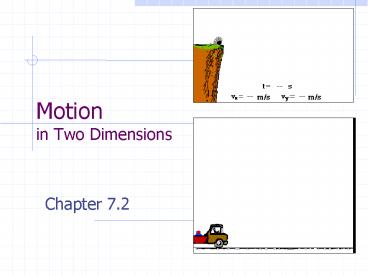Motion in Two Dimensions - PowerPoint PPT Presentation
Title:
Motion in Two Dimensions
Description:
Choosing Coordinates & Strategy For projectile motion: ... The Trajectory of a Projectile What does the free-body diagram look like for force? – PowerPoint PPT presentation
Number of Views:138
Avg rating:3.0/5.0
Title: Motion in Two Dimensions
1
Motionin Two Dimensions
- Chapter 7.2
2
Homework
- P. 158
- 9,10,11
- P.160.
- 12,13.
3
Projectile Motion
- What is the path of a projectile as it moves
through the air? - Parabolic?
- Straight up and down?
- Yes, both are possible.
- What forces act on projectiles?
- Only gravity, which acts only in the negative
y-direction. - Air resistance is ignored in projectile motion.
4
Choosing Coordinates Strategy
- For projectile motion
- Choose the y-axis for vertical motion where
gravity is a factor. - Choose the x-axis for horizontal motion. Since
there are no forces acting in this direction (of
course we will neglect friction due to air
resistance), the speed will be constant (a 0). - Analyze motion along the y-axis separate from the
x-axis. - If you solve for time in one direction, you
automatically solve for time in the other
direction.
5
The Trajectory of a Projectile
- What does the free-body diagram look like for
force?
6
The Vectors of Projectile Motion
- What vectors exist in projectile motion?
- Velocity in both the x and y directions.
- Acceleration in the y direction only.
vx (constant)
ax 0
vy (Increasing)
Trajectory or Path
- Why is the velocity constant in the x-direction?
- No force acting on it.
- Why does the velocity increase in the
y-direction? - Gravity.
7
Ex. 1 Launching a Projectile Horizontally
- A cannonball is shot horizontally off a cliff
with an initial velocity of 30 m/s. If the
height of the cliff is 50 m - How far from the base of the cliff does the
cannonball hit the ground? - With what speed does the cannonball hit the
ground?
8
Diagram the problem
vi
Fg Fnet
9
State the Known Unknown
- Known
- xi 0
- vix 30 m/s
- yi 0
- viy 0 m/s
- a -g
- y -50 m
- Unknown
- x at y -50 m
- vf ?
10
Perform Calculations (y)
- y-direction
- vy -gt
- y viyt ½ gt2
- Using the first formula above
- vy (-9.8 m/s2)(3.2 s) 31 m/s
11
Perform Calculations (x)
- x-Direction
- x vixt
- x (30 m/s)(3.2 s) 96 m from the base.
- Using the Pythagorean Theorem
- v vx2 vy2
- v (30 m/s)2 (31 m/s)2 43 m/s
12
Ex. 2 Projectile Motion above the Horizontal
- A ball is thrown from the top of the Science Wing
with a velocity of 15 m/s at an angle of 50
degrees above the horizontal. - What are the x and y components of the initial
velocity? - What is the balls maximum height?
- If the height of the Science wing is 12 m, where
will the ball land?
13
Diagram the problem
Fg Fnet
14
State the Known Unknown
- Known
- xi 0
- yi 12 m
- vi 15 m/s
- ? 50
- a -g
- Unknown
- ymax ?
- t ?
- x ?
- viy ?
- vix ?
15
Perform the Calculations (ymax)
- y-direction
- Initial velocity viy visin?
- viy (15 m/s)(sin 50)
- viy 11.5 m/s
- Time when vfy 0 m/s vfy viy gt
- t viy / g
- t (11.5 m/s)/(9.81 m/s2)
- t 1.17 s
- Determine the maximum height ymax yi viyt ½
gt2 - ymax 12 m (11.5 m/s)(1.17 s) ½ (9.81
m/s2)(1.17 s)2 - ymax 18.7 m
16
Perform the Calculations (t)
- Since the ball will accelerate due to gravity
over the distance it is falling back to the
ground, the time for this segment can be
determined as follows - Time when ball hits the ground ymax viyt ½
gt2 - Since yi can be set to zero as can viy,
- t 2ymax/g
- t 2(18.7 m)/ (9.81 m/s2)
- t 1.95 s
- By adding the time it takes the ball to reach its
maximum height to the time it it takes to reach
the ground will give you the total time. - ttotal 1.17 s 1.95 s 3.12 s
17
Perform the Calculations (x)
- x-direction
- Initial velocity vix vicos?
- vix (15 m/s)(cos 50)
- vix 9.64 m/s
- Determine the total distance x vixt
- x (9.64 m/s)(3.12 s)
- x 30.1 m
18
Analyzing Motion in the x and y directions
independently.
- x-direction
- dx vix t vfxt
- vix vi?cos?
- y-direction
- dy ½ (vi vf) t vavg t
- vf viy gt
- dy viy t ½ g(t)2
- vfy2 viy2 2gd
- viy vi?sin?
19
Key Ideas
- Projectile Motion
- Gravity is the only force acting on a projectile.
- Choose a coordinate axis that where the
x-direction is along the horizontal and the
y-direction is vertical. - Solve the x and y components separately.
- If time is found for one dimension, it is also
known for the other dimension.
20
There are only so many types of problems
- Vix constant
- Viy 0
- Viy gt0 (shooting upwards at an angle)
- Viy lt 0 (shotting down at an angle)
- a g
- a ltgtg































